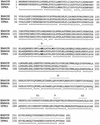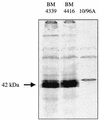VanD-type vancomycin-resistant Enterococcus faecium 10/96A
- PMID: 12499162
- PMCID: PMC149003
- DOI: 10.1128/AAC.47.1.7-18.2003
VanD-type vancomycin-resistant Enterococcus faecium 10/96A
Abstract
VanD type Enterococcus faecium 10/96A is constitutively resistant to vancomycin and to low levels of teicoplanin by nearly exclusive synthesis of peptidoglycan precursors terminating in D-alanyl-D-lactate (L. M. Dalla Costa, P. E. Reynolds, H. A. Souza, D. C. Souza, M. F. Palepou, and N. Woodford, Antimicrob. Agents Chemother. 44:3444-3446, 2000). A G(184)S mutation adjacent to the serine involved in the binding of D-Ala1 in the D-alanine:D-alanine ligase (Ddl) led to production of an impaired Ddl and accounts for the lack of D-alanyl-D-alanine-containing peptidoglycan precursors. The sequence of the vanD gene cluster revealed eight open reading frames. The organization of this operon, assigned to a chromosomal location, was similar to those in other VanD type strains. The distal part encoded the VanH(D) dehydrogenase, the VanD ligase, and the VanX(D) dipeptidase, which were homologous to the corresponding proteins in VanD-type strains. Upstream from the structural genes for these proteins was the vanY(D) gene; a frameshift mutation in this gene resulted in premature termination of the encoded protein and accounted for the lack of penicillin-susceptible D,D-carboxypeptidase activity. Analysis of the translated sequence downstream from the stop codon, but in a different reading frame because of the frameshift mutation, indicated homology with penicillin binding proteins (PBPs) with a high degree of identity with VanY(D) from VanD-type strains. The 5' end of the gene cluster contained the vanR(D)-vanS(D) genes for a putative two-component regulatory system. Insertion of ISEfa4 in the vanS(D) gene led to constitutive expression of vancomycin resistance. This new insertion belonged to the IS605 family and was composed of two open reading frames encoding putative transposases of two unrelated insertion sequence elements, IS200 and IS1341.
Figures






Similar articles
-
VanD-type vancomycin-resistant Enterococcus faecium and Enterococcus faecalis.Antimicrob Agents Chemother. 2004 Oct;48(10):3892-904. doi: 10.1128/AAC.48.10.3892-3904.2004. Antimicrob Agents Chemother. 2004. PMID: 15388450 Free PMC article.
-
New combinations of mutations in VanD-Type vancomycin-resistant Enterococcus faecium, Enterococcus faecalis, and Enterococcus avium strains.Antimicrob Agents Chemother. 2009 May;53(5):1952-63. doi: 10.1128/AAC.01348-08. Epub 2009 Mar 2. Antimicrob Agents Chemother. 2009. PMID: 19258279 Free PMC article.
-
Regulation of expression of the vanD glycopeptide resistance gene cluster from Enterococcus faecium BM4339.J Bacteriol. 2001 Jun;183(11):3436-46. doi: 10.1128/JB.183.11.3436-3446.2001. J Bacteriol. 2001. PMID: 11344152 Free PMC article.
-
Genetic characteristics of vancomycin resistance gene cluster in Enterococcus spp.Yi Chuan. 2015 May;37(5):452-7. doi: 10.16288/j.yczz.14-420. Yi Chuan. 2015. PMID: 25998433 Review.
-
Vancomycin resistance VanS/VanR two-component systems.Adv Exp Med Biol. 2008;631:200-13. doi: 10.1007/978-0-387-78885-2_14. Adv Exp Med Biol. 2008. PMID: 18792691 Review.
Cited by
-
First Isolation of Vancomycin-Resistant Enterococcus faecium Carrying Plasmid-Borne vanD1.Antimicrob Agents Chemother. 2022 Nov 15;66(11):e0102922. doi: 10.1128/aac.01029-22. Epub 2022 Oct 12. Antimicrob Agents Chemother. 2022. PMID: 36222537 Free PMC article.
-
VanD-type vancomycin-resistant Enterococcus faecium and Enterococcus faecalis.Antimicrob Agents Chemother. 2004 Oct;48(10):3892-904. doi: 10.1128/AAC.48.10.3892-3904.2004. Antimicrob Agents Chemother. 2004. PMID: 15388450 Free PMC article.
-
Characterization of vancomycin-resistance vanD gene clusters in the human intestinal microbiota by metagenomics and culture-enriched metagenomics.JAC Antimicrob Resist. 2023 Mar 24;5(2):dlad026. doi: 10.1093/jacamr/dlad026. eCollection 2023 Apr. JAC Antimicrob Resist. 2023. PMID: 36968950 Free PMC article.
-
Examination of the Clostridioides (Clostridium) difficile VanZ ortholog, CD1240.Anaerobe. 2018 Oct;53:108-115. doi: 10.1016/j.anaerobe.2018.06.013. Epub 2018 Jun 22. Anaerobe. 2018. PMID: 29940245 Free PMC article.
-
Diversity of plasmids and Tn1546-type transposons among VanA Enterococcus faecium in Poland.Eur J Clin Microbiol Infect Dis. 2017 Feb;36(2):313-328. doi: 10.1007/s10096-016-2804-8. Epub 2016 Oct 17. Eur J Clin Microbiol Infect Dis. 2017. PMID: 27752789 Free PMC article.
References
-
- Aiba, H., F. Nakasai, S. Mizushima, and T. Mizuno. 1989. Phosphorylation of a bacterial activator protein, OmpR, by a protein kinase, EnvZ, results in stimulation of its DNA-binding ability. J. Biochem. 106:5-7. - PubMed
-
- Arthur, M., F. Depardieu, L. Cabanié, P. Reynolds, and P. Courvalin. 1998. Requirement of the VanY and VanX D,D-peptidases for glycopeptide resistance in enterococci. Mol. Microbiol. 30:819-830. - PubMed
-
- Arthur, M., F. Depardieu, and P. Courvalin. 1999. Regulated interactions between partner and non partner sensors and response regulators that control glycopeptide resistance gene expression in enterococci. Microbiology 145:1849-1858. - PubMed
Publication types
MeSH terms
Substances
LinkOut - more resources
Full Text Sources
Other Literature Sources
Molecular Biology Databases

